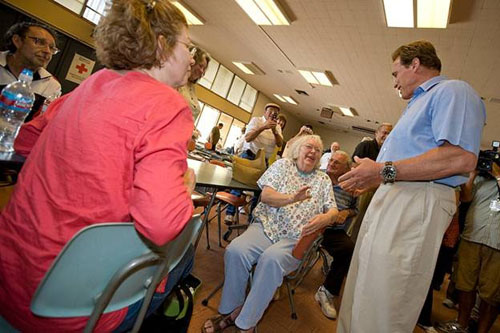
An “excessive” heatwave, expected later this week,
combined with smoke and air pollution from numerous wildfires,
prompted Governor Arnold Schwarzenegger today
to implement Phase II of California’s Contingency Plan.
Photo by Duncan McIntosh
From the Office of California Governor Arnold Schwarzenegger
July 7, 2008
In response to anticipated forecasts by the National Weather Service of temperatures in the 90s and 100s in many areas of California later this week and added concerns over increased levels of smoke and air pollution, Governor Arnold Schwarzenegger today directed the Governor’s Office of Emergency Services (OES), the California Department of Public Health (CDPH) and other state agencies to implement activities outlined in Phase II of California’s Contingency Plan for Excessive Heat Emergencies.
“We are coordinating with state and local agencies to help keep people safe during this excessive heat wave,” Governor Schwarzenegger said. “I urge all Californians to take proper health precautions as the temperatures rise into the 90s and 100s across the state – drink plenty of water and check on your neighbors who may be more vulnerable.”
Phase II activities include the coordination by OES of regularly scheduled conference calls with National Weather Service offices throughout the state, county emergency managers and representatives of key state agencies; increased outreach to the public and constituent groups by OES and other state agencies; the opening of cooling centers at state facilities; and contacts with licensed care facilities, hospitals and other facilities that serve seniors, persons with disabilities and other special needs populations.
The State Operations Center is already operating 24-hours a day to manage the state’s wildfire response, and they will now add key staff from other state agencies to closely monitor the heat wave and to respond to any heat-related issues. A list of current cooling centers opened by local authorities along with heat illness prevention tips is available on the front page of the OES website at www.oes.ca.gov.
The Governor urges all Californians living in or planning to visit areas for which extreme heat advisories and warnings are issued by the National Weather Services to prepare for the hot weather and use caution in their activities.
There will also be excessive smoke in many areas as a result of the state’s wildfires, so the Governor and public health officials continue to encourage people in those areas to stay inside and limit their physical activity, especially children, the elderly and people with asthma and other respiratory problems.
Californians can reduce their risk of heat-related illness by:
Creating a cooler environment by making sure that window air conditioners are installed snugly and ducts are properly insulated, weather stripping doors and sills and placing window reflectors made of cardboard covered with aluminum foil between windows and drapes
Drinking plenty of water, especially when taking medication
Wearing lightweight and light-colored clothing
Avoiding physical activities during periods of peak temperatures
Checking on neighbors, family members and pets to ensure they are not being harmed by the heat
Watching for signs of heat-related illness, including fatigue, nausea, headache and vomiting
Visiting malls, theaters and other public places that are air-conditioned if a person doesn’t have his or her own air conditioning
To reduce the risk of heat illness for those working outdoors, drink plenty of water (at least one quart per hour), take necessary breaks in the shade for at least five minutes when an employee believes they need a preventative recovery period and make sure all employees are trained about heat illness prevention before they begin working.
State agency activities in response to the National Weather Service forecast include:
Regular contacts of licensed facilities under the jurisdiction of CDPH, the Department of Social Services and the Department of Mental Health
Working to get the word out to vulnerable populations about heat-related assistance and prevention by California Volunteers, in partnership with local non-profits and government agencies in impacted communities
Monitoring agriculture impacts by and assessing fairground availability for cooling centers for persons and livestock by the California Department of Food and Agriculture
Coordination of daily conference calls by OES with the National Weather Service, county emergency managers and representatives of key state agencies
Outreach and the enforcement of heat illness prevention regulations in workplaces by Cal/OSHA
Dissemination of information regarding the heat situation by CDPH to local health departments via the California Health Alert Network
Posting of heat related information on various state Web sites, including OES, CDPH and Cal/OSHA


 The Hunger Site
The Hunger Site
No Comments
Comments for Schwarzenegger Activates State’s Plan
for Excessive Heat Emergencies are now closed.